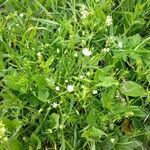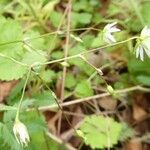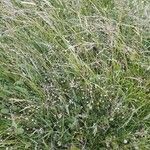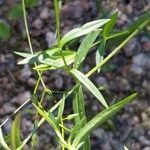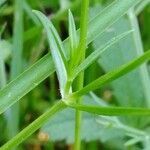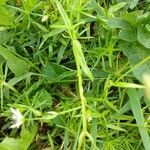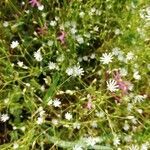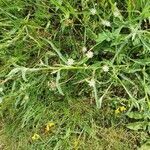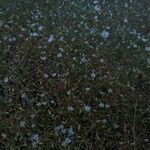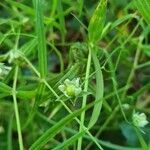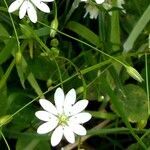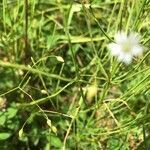Plants perennial, coarse, rhi-zomatous; rhizomes slender, elongate. Stems decumbent or ascending, straggling, diffusely branched, smoothly 4-angled, 20-90 cm, brittle, glabrous. Leaves sessile; blade linear-lanceolate to narrowly lanceolate, widest near base, 1.5-4 cm × 1-6 mm, base round, margins smooth, apex acute, often ciliate near base, otherwise glabrous, not glaucous. Inflorescences terminal, 5-many-flowered, open, conspicuously branched cymes; bracts narrowly lanceolate, 1-5 mm, wholly scarious, margins ciliate, apex acuminate. Pedicels divaricate, 10-30 mm, glabrous. Flowers 5-12 mm diam., rarely larger; sepals 5, distinctly 3-veined, narrowly lanceolate to triangular, 3-7 mm, margins narrow, straight, scarious, apex acute, glabrous; petals 5, 3-7 mm, equaling or longer than sepals; stamens 10, all, some, or none fully developed and fertile; styles 3, ascending, ca. 3 mm. Capsules green or straw colored, narrowly ovoid, 5-7 mm, longer than sepals, apex acute, opening by 3 valves, splitting into 6; carpophore absent. Seeds reddish brown, reniform-rotund, ca. 1 mm diam., rugose in concentric rings. 2n = 39, 52.
Herbs perennial, often glabrous. Stems densely tufted, slightly erect, quadrangular, 10--30 cm tall, slender, glabrous or with 2 lines of hairs; sterile branches axillary from proximal leaves present. Leaves sessile, pinkish green, linear to lanceolate, 0.5--4(--5) cm × 1.5--3(--4) mm, basal margin sparsely ciliate, midvein inconspicuous, base slightly narrowed, apex acute. Flowers many or sometimes few, in terminal or axillary cymes, 7--11 mm in diam.; bracts lanceolate, 2(--5) mm, midvein conspicuous, margin membranous. Pedicel 0.5--2.5 cm, to 3.8 cm in fruit, slender. Sepals 5, green, lanceolate or narrowly lanceolate, 4--4.5 mm or longer, shiny, 3-veined, margin membranous, apex acuminate. Petals 5, slightly shorter or longer than sepals, 2-cleft nearly to base. Stamens 10; filaments filiform, glabrous, 4--4.5 mm; anthers brown, broadly ellipsoid, ca. 0.3 mm. Ovary ovoid-oblong; styles 3(or 4), ca. 2 mm. Capsule ovoid-cylindric, much longer than persistent sepals. Seeds black-brown, nearly compressed orbicular, granulose. Fl. May--Jul, fr. Aug--Sep. 2n = 26, 39, 52.
Perennial; stems weak, 3–5 dm, glabrous or sometimes scabrous on the 4 prominent angles; lvs 1.5–5 cm × 1.5–7 mm, linear to lance-linear, often ciliate at base; infl terminal, diffuse, often extending half-way to the base; bracts scarious, ciliolate at the base; pedicels slender, spreading or reflexed; sep lanceolate, acute or acuminate, strongly 3-nerved, 4.5–5.5 mm in fr, the margins scarious, commonly ciliolate at least at base; pet shorter than to barely surpassing the sep, bifid almost to the base; fr stramineous, about equaling or somewhat surpassing the sep; seeds 0.8–1.2 mm, oblong-subreniform or orbicular-subreniform, coarsely rugose-tuberculate; 2n=26, 39. Native of Europe, intr. in grassy places, fields, roadsides, etc., from Nf. and Que. to Minn., s. to S.C. and Kans. May–July. (Alsine g.)
Perennial. Stems weak, ascending, 4-angled, glabrous, 15-60-(100) cm long. Lvs green, sessile, connate in pairs, narrow-oblanceolate to narrow-lanceolate below, narrow-lanceolate or becoming linear-lanceolate above, tapering gradually to acute apex and sparsely ciliate or glabrous base, (10)-15-30-(50) × 3-5-(8) mm; margin flat; marginal vein obscure or 0. Infl. a terminal dichasium, lax, (10)-20-60-flowered. Bracts ovate-acuminate to subulate, keeled, 4-7 × 1-3 mm; margins scarious, ciliate. Pedicels slender, patent, glabrous, 10-30-(50) mm long. Sepals narrow-triangular, acute, 3-veined, 4-7 mm long; margins scarious, ciliate. Petals 4-9 mm long, c. = or slightly > sepals. Stamens 10 or fewer. Capsule narrow-ovoid, = or > calyx. Seeds dull brown, c. 1 mm long; papillae low, elongate.
A herb that keeps growing from year to year. It scrambles 50 cm tall. The flowers are white.
